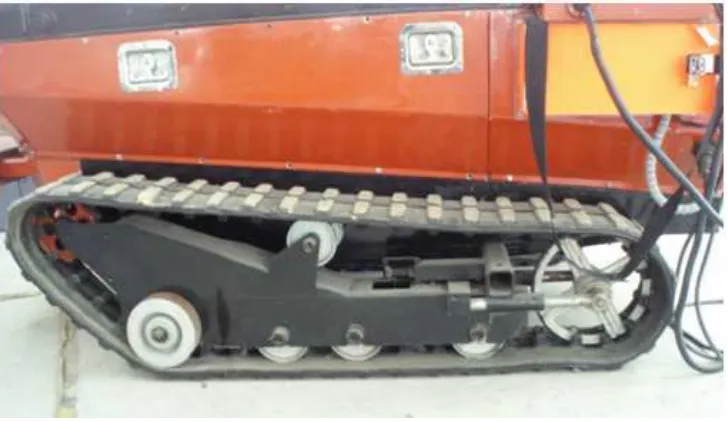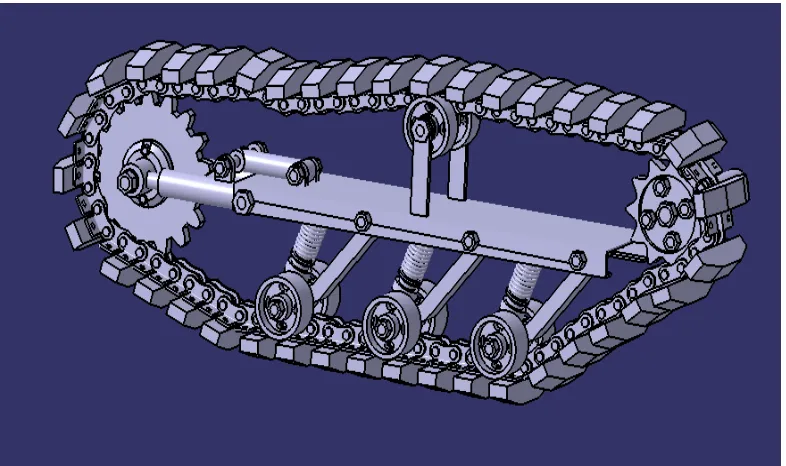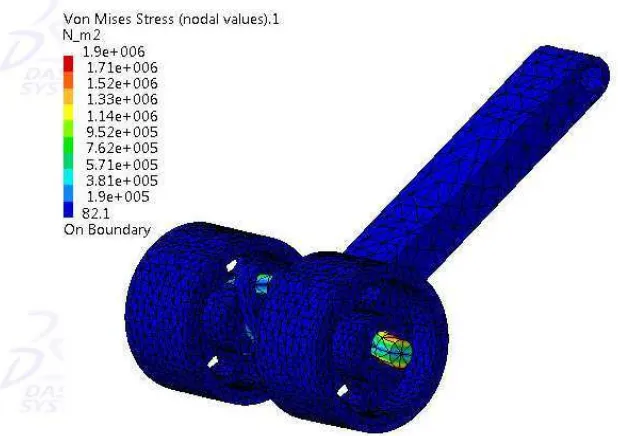Up-Scaling and Optimisation of Fire Fighting Ground Vehicle Track
System
CheeFai Tan
1, a, Ranjit Singh Sarban Singh
2, V.K. Kher
1and H.F. Kong
1 1Integrated Design Research Group (IDEA),Faculty of Mechanical Engineering, Universiti Teknikal Malaysia Melaka (UTeM), Melaka, Malaysia
2
Faculty of Electronic and Computer Engineering, Universiti Teknikal Malaysia Melaka (UTeM), Melaka, Malaysia
a
Keywords: Fire fighting machine; Track system; Absorber; Up-scaling and optimisation
Abstract. Current UTeM’s fire fighting machine is developed to operate indoor only. It is not efficient when it is operating on rocky surfaces (outdoor) as it faces the problem of shock and vibration reduction. The track system of the machine cannot move smoothly because the rollers are fixed to the chassis. This paper describes the method of up-scaling and optimising the track system for the current fire fighting machine. The new track system concept is firstly developed by using Computer-Aided Design (CAD) and Computer Aided Engineering (CAE) software. Subsequently a prototype is built to validate the functionality of the new track system which is more efficient in absorbing the vibration and shock. Analysis and optimisation of the prototype is performed using CAD method with the CATIA V5 R16 software.
Introduction
According to the statistics on death rate of fire fighters reported in the USA during the early 1980s, 1.9 fire fighters were reported to be killed per year for every 100,000 structure fires [1]. This rate however increased to 3.0 fatalities for every 100,000 structure fires during the 1990s [2]. The reported causes for Line of Duty Deaths (LODD) include smoke inhalation, crushing injuries and burns [3]. This scenario triggered the need to develop fire fighting technologies where companies in the USA and Japan have been extensively involved in the research and development of fire fighting technology. Many studies [4-8] were made on replacing fire fighters with machines in dangerous situations to reduce the fatalities of fire fighters. The fire fighting machines can assist the fire fighters in extinguishing fire in the dangerous areas without the fire fighters themselves needed to be present at the area.
Current UTeM’s Fire Fighting Machine. Current UTeM’s fire fighting machine (Fig. 1) was built in 2007 by the Faculty of Mechanical Engineering (FKM) with the collaboration of a local engineering company. The main goal of the machine is to extinguish fire in situations that will cause harm to human lives.
It is composed of metal body, electrical and electronic board, hydraulic components and mechanical components. The machine is run by two electric direct current motor made by Sanpo Electric Co. Ltd. with six rechargeable batteries. The fire fighting machine is controlled by using radio frequency control where the operator can operate the machine in a safe distance from fire. The track system of the machine is consists of a heavy duty belt, one drive sprocket, one idler sprocket and five bogies (Fig. 2). However, the current track system shown in Fig. 2 does not have suspension system to absorb vibration and shock. Therefore, when the fire fighting is moving on rough terrains sharp jolts will be created causing the track to lift from the ground and eventually makes manoeuvring difficult. Besides, the vibration and shock will also cause damage to the track system.
Applied Mechanics and Materials Vol. 315 (2013) pp 236-240 © (2013) Trans Tech Publications, Switzerland
doi:10.4028/www.scientific.net/AMM.315.236
Figure 1. Current UTeM's fire fighting machine
Figure 2. Track system of UTeM's fire fighting machine
Methodology
Firstly, CATIA V5 R16 is be used to create the actual drawing with actual dimensions which include part designs, assembly drawings and exploded drawings. Subsequently, the bill of materials (BOM) is generated for cost estimation purposes. A prototype of the track system is built by using aluminium for the body, small wheel and conveyor belt for the track system.
After obtaining the design, Finite Element Analysis (FEA) software is used to perform analysis on the design. Some assumptions were made to choose the material and allowable weight to set the boundaries for analysis purposes. Results from the analysis are able to measure the force that can be exerted on the track system.
design parameters. Then an optimisation algorithm is used to compute new design parameters until an optimum design is achieved.
Selected Conceptual Design. The selected conceptual design shown in Fig. 3 is using roller chain as its track because roller chain has no slippage or creep. Thus, there will not be issue of power lost due to slippage. Moreover, roller chain can drive a number of shafts from a single source of power and the failure rate of roller chain is also very low due to low tensile strength. Chain drives are more practical to operate at low speed as well as high temperature. The ability of chain drives to withstand deterioration caused by oil, grease, sunlight, chemical and abrasive conditions is also an important factor to choose it as the track. Roller chains can also operate in wet conditions with lesser problems as compared to belts. On the other hand, the rigid frame type I is used for the chassis because it is more suitable to withstand high moment, stress and force. Besides, it is not easily damaged due to vibration and shock because of its rigidity. The shock absorber will be fitted with motorcycle shock absorbers.
Figure 3. Selected conceptual design
Simulation and Analysis Results
Catia V5R16 is used to do simulation and analysis on the shaft of the roller in order to compare the current fire fighting machine with new conceptual design. This is because the new conceptual design does not based on the current one but it is a whole new concept. The current track system will be compared to the new track system in the terms of Von Mises stress.
According to Von Mises Stress (Distortion Energy Theory), it proposes that the total strain energy can be separated into two components: the volumetric (hydrostatic) strain energy and the shape (distortion or shear) strain energy. It is proposed that yield occurs when the distortion component exceeds that at the yield point for a simple tensile test. The yield started at the edge of the current track system’s roller which is shown in the Fig. 4 when a large force exerted on it. This is because most of the stress caused by the body weight is exerted on the roller. Compare to the new conceptual design in the Fig. 5, the yield is started at the shaft only. However, the roller and its holder remain on its state. The yield is more on the shaft because it is distorted by the tensile force from the suspension system and the roller holder.
Figure 4. Von Mises Stress analysis of current fire fighting machine
Figure 5. Von Mises Stress analysis of new conceptual design
Discussions and Conclusion
In conclusion, the state of art of the track system for the existing fire fighting machine has been studied. An improved track system has been designed and developed followed by up-scaling and optimising the new track system CATIA V5R16. From the result, it is shown that the new design of fire fighting machine track system has improvement compared to the current UTeM fire fighting machine. The problem of shock and vibration absorption that the when moving on a rocky surface has been solved by using absorber in the track system.
Acknowledgement
This project is funded by Universiti Teknikal Malaysia Melaka (UTeM) under the Short Term Research Grant. Special thanks to Faculty of Mechanical Engineering for the support.
References
[1] International Association of Fire Fighters (IAFF), 2000, “Death and Injury Survey, Washington,” Available from: http://www.iaff.org/ HS/PDF/ 2000%20D&I.pdf. Accessed on 5th September 2008.
[2] S.N. Kyle, 2007, “NFPA Releases Firefighter Death Study, U.S.A,” Available from: http://cms.firehouse.com/content/section/news. Accessed on 5th September 2008.
[3] N. Rosmuller and B.J.M., Ale, “Classification of fatal firefighter accidents in the Netherlands: Time pressure and aim of the suppression activity,” Journal of Safety Science, 2008, 46, page 282 –290.
[4] Shanghai Qiangshi Fire-fighting Equipment Co. Ltd., 2007, “Qiangshi Fire Fighting Robot, China,” Available from: www.qs119.com/en/ showpro.asp?id=530. Accessed on 5th September 2008.
[5] E. Sofge, 2007, “First Firefighting Robots Deployed, Could Spark Autonomous Dept. Las Vegas,” Available from: http://www.popularmechanics.com/science/roboticsl. Accessed on 5th September 2008.
[6] A. Konda, “The Fire Fighting Snake Robot. Europe,” Available from: http://www.sintef.com. Accessed on 4th September 2008.
[7] HKFSD, “Mobile Fire Fighting Supporting Machine LUF 60R. China,” Available from: http://www.hkfsd.gov.hk/home/images/ equipment/fire/e_luf60.html. Accessed on 13th September 2008.
[8] NEVA, “Mobile Fire Fighting Robot. Russia,” Available from: http://www.neva.ru/CNII-RTC/Firemen/html. Accessed on 13th September 2008.


